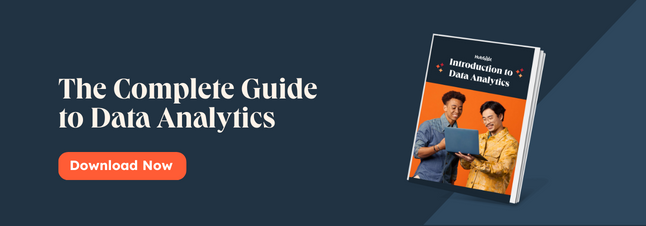The single source of truth is a concept we all search for in our lives, especially in the business world. Businesses strive to build an automated and efficient system for serving customers, and this vision is often described as a "well-oiled machine." Consider a similar metaphor for describing a single source of truth philosophy: an all-wheel-drive vehicle.

![Download Now: Introduction to Data Analytics [Free Guide]](https://no-cache.hubspot.com/cta/default/53/8982b6b5-d870-4c07-9ccd-49a31e661036.png) In all-wheel-drive cars, a central computer tracks tire traction and adjusts power allocation to ensure the vehicle stays on course. This data also feeds into other systems, providing drivers with information to make informed decisions. Similarly, organizations adopt the single source of truth principle to consolidate data and drive their business strategy.
In all-wheel-drive cars, a central computer tracks tire traction and adjusts power allocation to ensure the vehicle stays on course. This data also feeds into other systems, providing drivers with information to make informed decisions. Similarly, organizations adopt the single source of truth principle to consolidate data and drive their business strategy.
- Single Source of Truth Benefits
- Challenges for Single Source of Truth Adoption
- Single Source of Truth Examples
- Build a single source of truth to improve insights.
What is a single source of truth?
Single source of truth (SSOT) is a philosophy for collecting data from across the enterprise and aggregating it into a central repository.
.png?width=650&name=Single%20Source%20of%20Truth%20(V4).png)
As organizations grow, data relevant to different parts of the business often resides in specific applications and systems. However, this data also influences decisions made by teams outside of the ones generating it. For example, data on followers for a company's social media accounts can help email marketers identify new audience segments.
Subpar data leads to subpar decisions. That's why companies adopt SSOT approaches to gain a comprehensive view of customer needs and business impact, enabling sales teams to effectively understand customer backgrounds and address pain points, even without access to follower data in usual datasets.
This video provides a second examination of the SSOT principle and how it's applied in the design of a mobile application:
Single Source of Truth Benefits
When organizations align their data strategy with an SSOT philosophy, it provides multiple benefits for the enterprise and individual employees.
Build a complete view of business performance.
Combining financial, customer, marketing, sales, and IT data allows organizations to measure the contribution of each business unit towards the overall mission, track progress, and predict future growth and trends.
Break down data silos.
Implementing SSOT principles allows organizations to make strategic shifts without overlooking dependencies or trends, as data from different teams can inform decisions beyond their own scope.
Eliminate duplicate data.
SSOT eliminates duplicate data, optimizing storage resources while ensuring both teams have access to the information. This integration of data also prevents teams from drawing different conclusions if one dataset is more recent or more complete than the other, which improves data quality.
Increase transparency.
SSOT promotes transparency and allows employees to understand how their individual efforts contribute to company goals. Dashboards and visualizations help communicate this data to team members.
Increase productivity.
With an SSOT approach, team members no longer have to pull data from multiple sources to build reports. Analysts and stakeholders spend less time collecting data and more time finding new insights and drawing conclusions.
Support new strategies with data.
The entire enterprise can act with greater confidence when all data has been accounted for in a central data warehouse or other datastore. Employees can propose new strategies and support their ideas with data, increasing innovation. There may be additional benefits depending on your organization's use of SSOT. Let's now explore the challenges that come with shifting to SSOT principles.
Challenges for Single Source of Truth Adoption
The SSOT philosophy has many benefits, but a large shift in strategy brings challenges that should be accounted for to ensure successful adoption.
Leadership and Employee Buy-In
Leadership buy-in is crucial for a major project like a shift to SSOT. Clear communication with the entire team about the migration timetable is also important to avoid confusion and maintain productivity.
High-Quality Data
Implementing data quality rules is essential for maximizing the long-term value of collected enterprise data. By ensuring data follows agreed-upon standards, organizations can reduce confusion, accelerate analysis, and boost employee confidence in their conclusions.
Evaluation Standards
To ensure consistency and transparency, establish standards for evaluating data in your universal datastore. This prevents different conclusions from being drawn from the same dataset, while still allowing room for innovation.
Data Privacy
To ensure data privacy, implement role-based access rules to limit sensitive information to those who require it. For instance, an HR professional may have access to employees' Social Security numbers, while a business executive should not. Role-based permissions also help with compliance to data privacy regulations.
Accessibility
To democratize data accessibility, provide self-service tools for building dashboards and visualizations, allowing all employees to feel ownership and engagement in achieving team and organizational goals.
The next section will examine different business examples of SSOT in action.
Single Source of Truth Examples
Now that you understand the challenges of a SSOT philosophy, let's examine some use cases from successful adoptions of this principle.
-1.png?width=650&name=Single%20Source%20of%20Truth%20(V4)-1.png)
1. Software Development
In agile or DevOps software development teams, a SSOT is crucial for aligning the team and accelerating the development lifecycle. Storing data on requirements, task completion, bugs, and more in one place helps evaluate future projects and proactively avoid roadblocks.
2. Regulatory Compliance
Consolidating data under SSOT simplifies compliance with regulations like HIPAA or GDPR by providing oversight of all data in a central repository. It also allows organizations to easily update data management strategies to comply with future mandates.
3. Search Engines
Search engines like Google use the SSOT philosophy to catalog and deliver relevant results to users. Organizations can also build search applications for employees to query their central datastore.
This video discusses the principles of SSOT and how they are applied in another SSOT use case, a document lifecycle strategy:
Build a single source of truth to improve insights.
A single source of truth approach helps organizations establish common ground for evaluating and solving business obstacles.
SSOT ensures unified data for tracking performance metrics, preventing subpar decisions and guiding your organization in the right direction.








